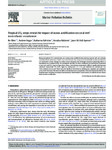Tropical CO2 seeps reveal the impact of ocean acidification on coral reef invertebrate recruitment
| dc.contributor.author | Allen, R | |
| dc.contributor.author | Foggo, Andrew | |
| dc.contributor.author | Fabricius, K | |
| dc.contributor.author | Balistreri, A | |
| dc.contributor.author | Hall-Spencer, Jason | |
| dc.date.accessioned | 2017-01-05T10:41:07Z | |
| dc.date.available | 2017-01-05T10:41:07Z | |
| dc.date.issued | 2016-12-29 | |
| dc.identifier.issn | 0025-326X | |
| dc.identifier.issn | 1879-3363 | |
| dc.identifier.uri | http://hdl.handle.net/10026.1/8196 | |
| dc.description.abstract |
Rising atmospheric CO2 concentrations are causing ocean acidification by reducing seawater pH and carbonate saturation levels. Laboratory studies have demonstrated that many larval and juvenile marine invertebrates are vulnerable to these changes in surface ocean chemistry, but challenges remain in predicting effects at community and ecosystem levels. We investigated the effect of ocean acidification on invertebrate recruitment at two coral reef CO2 seeps in Papua New Guinea. Invertebrate communities differed significantly between 'reference' (median pH7.97, 8.00), 'high CO2' (median pH7.77, 7.79), and 'extreme CO2' (median pH7.32, 7.68) conditions at each reef. There were also significant reductions in calcifying taxa, copepods and amphipods as CO2 levels increased. The observed shifts in recruitment were comparable to those previously described in the Mediterranean, revealing an ecological mechanism by which shallow coastal systems are affected by near-future levels of ocean acidification. | |
| dc.format.extent | 607-613 | |
| dc.format.medium | Print-Electronic | |
| dc.language | en | |
| dc.language.iso | en | |
| dc.publisher | Elsevier BV | |
| dc.subject | Marine invertebrates | |
| dc.subject | Marine communities | |
| dc.subject | Coastal habitats | |
| dc.subject | Settlement | |
| dc.subject | CO2 seeps | |
| dc.subject | Pacific Ocean | |
| dc.title | Tropical CO2 seeps reveal the impact of ocean acidification on coral reef invertebrate recruitment | |
| dc.type | journal-article | |
| dc.type | Journal Article | |
| plymouth.author-url | https://www.webofscience.com/api/gateway?GWVersion=2&SrcApp=PARTNER_APP&SrcAuth=LinksAMR&KeyUT=WOS:000417964500005&DestLinkType=FullRecord&DestApp=ALL_WOS&UsrCustomerID=11bb513d99f797142bcfeffcc58ea008 | |
| plymouth.issue | 2 | |
| plymouth.volume | 124 | |
| plymouth.publication-status | Published | |
| plymouth.journal | Marine Pollution Bulletin | |
| dc.identifier.doi | 10.1016/j.marpolbul.2016.12.031 | |
| plymouth.organisational-group | /Plymouth | |
| plymouth.organisational-group | /Plymouth/Faculty of Science and Engineering | |
| plymouth.organisational-group | /Plymouth/Faculty of Science and Engineering/School of Biological and Marine Sciences | |
| plymouth.organisational-group | /Plymouth/PRIMaRE Publications | |
| plymouth.organisational-group | /Plymouth/REF 2021 Researchers by UoA | |
| plymouth.organisational-group | /Plymouth/REF 2021 Researchers by UoA/UoA07 Earth Systems and Environmental Sciences | |
| plymouth.organisational-group | /Plymouth/Research Groups | |
| plymouth.organisational-group | /Plymouth/Research Groups/Marine Institute | |
| plymouth.organisational-group | /Plymouth/Users by role | |
| plymouth.organisational-group | /Plymouth/Users by role/Academics | |
| dc.publisher.place | England | |
| dcterms.dateAccepted | 2016-12-11 | |
| dc.rights.embargodate | 2017-12-29 | |
| dc.identifier.eissn | 1879-3363 | |
| dc.rights.embargoperiod | Not known | |
| rioxxterms.versionofrecord | 10.1016/j.marpolbul.2016.12.031 | |
| rioxxterms.licenseref.uri | http://www.rioxx.net/licenses/all-rights-reserved | |
| rioxxterms.licenseref.startdate | 2016-12-29 | |
| rioxxterms.type | Journal Article/Review |


